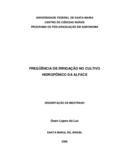| dc.creator | Luz, Gean Lopes da | |
| dc.date.accessioned | 2017-05-05 | |
| dc.date.available | 2017-05-05 | |
| dc.date.issued | 2008-02-21 | |
| dc.identifier.citation | LUZ, Gean Lopes da. Freqüência de irrigação no cultivo hidropônico da alface. 2008. 65 f. Dissertação (Mestrado em Agronomia) - Universidade Federal de Santa Maria, Santa Maria, 2008. | por |
| dc.identifier.uri | http://repositorio.ufsm.br/handle/1/4980 | |
| dc.description.abstract | The objective of the work was to verify the influence of four intervals between the irrigations on the production of lettuce in hydroponics system and the retention of nutrient solution, besides more determining the best interval between irrigation at each time of cultivation. The experiments were carried out at four times during one year, in the nutrient film technique (NFT), inside a polyethylene greenhouse. The experimental designer was randomized complete blocks in a factorial scheme 4x4, consisted of four intervals between irrigations (T15 - 15 min of irrigation at intervals of 15 min; T30 - 15
min of irrigation at intervals of 30 min; T45 - 15 min of irrigation at intervals of 45 min and T60 - 15 min of 60 irrigation at intervals of min) and four times of cultivation (spring, summer, autumn and winter). Had been determined the temperature and the incident global radiation inside of the greenhouse, as well as the electric energy consumption in each treatment. There were no interaction between times of
cultivation and irrigation regimes for the variables dry biomass of leaves (FMSF), of steam (FMSC), of roots (FMSR) and total (FMST), leaf area index (IAF), volume of the roots (VR) and retention of nutrient solution in the roots (RET). There were significant differences among intervals between irrigations just for FMSR and VR. To times of cultivation there were significant differences for all the variables, which are attributed to the distinct meteorological conditions of each time. The FMSF and IAF were not reduced by the magnification of the interval between irrigation since 15 up to 60 min. The FMSR and the VR enlarged with the magnification of the interval between irrigation, causing retention
of the nutritional solution. This retention allowed the magnification of the interval between irrigation without the incidence of water deficit. In all the times of cultivation, the T60 treatment was adjusted, showing a decrease of 53.57% in electric consumption compared to T15, without reduction in
productivity. | eng |
| dc.description.sponsorship | Conselho Nacional de Desenvolvimento Científico e Tecnológico | |
| dc.format | application/pdf | por |
| dc.language | por | por |
| dc.publisher | Universidade Federal de Santa Maria | por |
| dc.rights | Acesso Aberto | por |
| dc.subject | Irrigação | por |
| dc.subject | Hidroponia | por |
| dc.subject | Sistema radicular | por |
| dc.subject | Lactuca sativa L. | por |
| dc.subject | Irrigation | eng |
| dc.subject | Hydroponics system | eng |
| dc.subject | Roots | eng |
| dc.subject | Lactuca sativa L. | eng |
| dc.title | Freqüência de irrigação no cultivo hidropônico da alface | por |
| dc.type | Dissertação | por |
| dc.description.resumo | O objetivo do trabalho foi verificar a influência de quatro intervalos entre irrigações sobre a produção de alface em hidroponia e a retenção de solução nutritiva, além de determinar o intervalo entre irrigações mais adequado em cada época de cultivo. Foram realizados experimentos em quatro épocas durante um ano, conduzidos em hidroponia no sistema de fluxo laminar de nutrientes (NFT), sob estufa plástica. Adotou-se o delineamento experimental de blocos ao acaso em esquema fatorial 4x4, constituído por quatro intervalos entre irrigações (T15 - 15 min de irrigação a intervalos de 15 min; T30 - 15 min de irrigação a intervalos de 30 min; T45 - 15 min de irrigação a intervalos de 45 min
e T60 - 15 min de irrigação a intervalos de 60 min) e quatro épocas de cultivo (primavera, verão, outono e inverno). Foram realizadas análises de fitomassa seca de folhas (FMSF), caule (FMSC), raízes (FMSR) e total (FMST), índice de área foliar (IAF), volume do sistema radicular (VR) e retenção
de solução nutritiva pelo sistema radicular (RET). Também foram determinadas a temperatura do ar e a radiação global incidente no interior da estufa, bem como o consumo de energia elétrica em cada tratamento. Observaram-se diferenças significativas entre tratamentos (P<0,05) apenas para FMSR e VR. Entre as épocas de cultivo foram encontradas diferenças significativas (P<0,05) em todas as
variáveis analisadas, as quais são atribuídas às condições meteorológicas distintas de cada cultivo. Não houve interação entre os fatores para nenhuma variável avaliada. A produção de FMSF e de área foliar da alface não foi prejudicada pela ampliação do intervalo entre irrigações desde 15 até 60
min. Ocorreu incremento da FMSR e do VR das plantas com a ampliação do intervalo entre irrigações, promovendo retenção da solução nutritiva. Essa retenção permitiu a ampliação do
intervalo entre irrigações sem a ocorrência de deficiência hídrica. Em todas as épocas, o tratamento T60 foi o mais adequado, por permitir uma economia de energia elétrica de até 53,57% sem prejuízos à produtividade da cultura. | por |
| dc.contributor.advisor1 | Medeiros, Sandro Luis Petter | |
| dc.contributor.advisor1Lattes | http://buscatextual.cnpq.br/buscatextual/visualizacv.do?id=K4784158A8 | por |
| dc.contributor.referee1 | Manfron, Paulo Augusto | |
| dc.contributor.referee1Lattes | http://buscatextual.cnpq.br/buscatextual/visualizacv.do?id=K4798725P1 | por |
| dc.contributor.referee2 | Leão, José Domingos Jacques | |
| dc.contributor.referee2Lattes | http://buscatextual.cnpq.br/buscatextual/visualizacv.do?id=K4249683J7 | por |
| dc.creator.Lattes | http://buscatextual.cnpq.br/buscatextual/visualizacv.do?id=K4772415P3 | por |
| dc.publisher.country | BR | por |
| dc.publisher.department | Agronomia | por |
| dc.publisher.initials | UFSM | por |
| dc.publisher.program | Programa de Pós-Graduação em Agronomia | por |
| dc.subject.cnpq | CNPQ::CIENCIAS AGRARIAS::AGRONOMIA | por |


